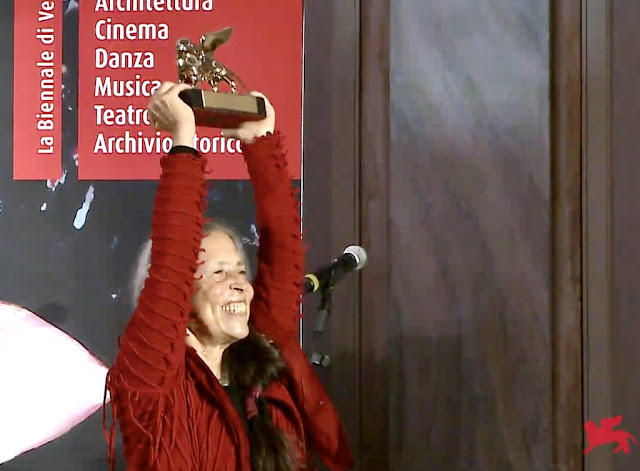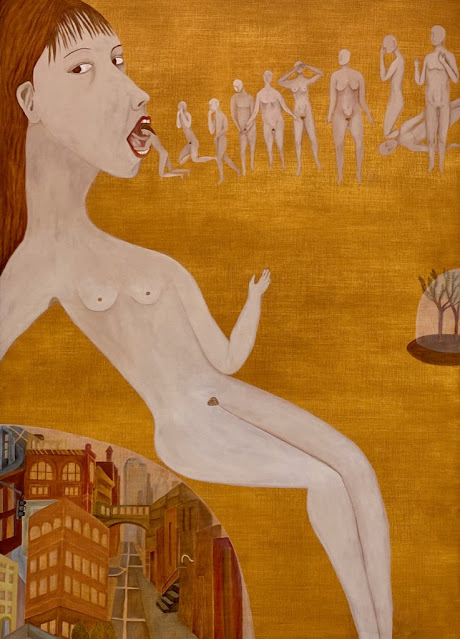Collateral Event - La Biennale di Venezia - Biennale Arte 2022
Fondazione dell' Albero d'Oro - Palazzo Vendramin Grimani
Bosco Sodi - What Goes Around Comes Around
Party Photos
In the recently restored Palazzo Vendramin Grimani on the Canal Grande the Fondazione dell'Albero d'Oro presented a new project - curated by Daniela Ferretti and Dakin
Hart - entitled - Bosco Sodi at Palazzo Vendramin Grimani - What Goes Around Comes
Around - until November 27. Mexican artist Bosco Sodi created the paintings and sculptures during a period of residency on site in the palazzo in Venice this Spring.
“controlled chaos.
something that is
completely unrepeatable.”
Bosco Sodi - 1970 -
is celebrated internationally for his use
of raw, natural materials in large-scale textured paintings and sculpture
that brim with emotive power. The essential simplicity of his materials and the
vivid pigments he sources from around the globe are the focus of his
process-based exploration of the creative gesture. Sodi has described his
creative process as a “controlled chaos” that makes “something that is
completely unrepeatable.”
Bosco Sodi
The ground floor of the palazzo was transformed into Bosco Sodi's studio during his residency this spring. There, the artist realized
some works for the exhibition, drawing on Venice’s unique history as a
dynamic hub for cultural and
commercial exchanges between Europe, Asia, and the rest of the world.
The Ground Floor
"‘revenge’ of all that is raw, unprocessed."
In the installation for Palazzo Vendramin Grimani, visitors can witness an abrupt reversal of that
ancient flow of trade between Europe and the Americas. The opulent
interiors of merchant houses like Palazzo Vendramin Grimani preserve the memory
of what was, historically, a one-way flow of materials. Sodi’s temporary
occupation of the palazzo’s walls and
floors with works closely linked to the material instinct that produces them lead to a sort of ‘revenge’ of all that is raw, unprocessed.
Daniela Ferretti
co-curator
On the piano nobile, the rough, intensely
coloured surfaces that are typical of Bosco Sodi form a contrast with the monumental spaces of
the drawing room and the side rooms, with the colours of their plasterwork and
tapestries, with the textures of the Venetian terrazzo floors, with the
reflections of mirrors clouded by time, with the ceilings decorated with
neoclassical frescoes, thick wooden beams or eighteenth-century stuccoes, and
with the shimmering light streaming through the windows overlooking the Canal Grande.
The Piano Nobile
Gilles Etrillard and Beatrice de Reynies
The careful selection and use of precious pigments is one of the characteristics of Sodi’s art: some of them have a rich historical background.
Before
the invention of synthetic pigments, the colour obtained from cochineal was the
international standard for red. The luxurious red fabrics that dot Titian’s
canvases are, quite literally, appropriations from the Americas. Cochineal,
which is still produced in Oaxaca - Mexico - has recently seen an increase in
demand, thanks to the growing demand for natural pigments.
The Piano Nobile
Mattia Berto and Roberto Piffer
In addition, in
parallel with the installation of the works made on site, Sodi placed 195 small clay spheres on the floor of
the exhibition spaces, moulded from the soil of Oaxaca and baked there in an
improvised oven on the beach. The figure corresponds to the current number of
nation-states on Earth. Each visitor is invited to move one of the miniature globes during their visit. In this
way the installation will change a little every day and the different locations
of the globes will be periodically photographed in order to document the
evolution of the work. At the end of the exhibition, residents of the city of
Venice who visit the space will be able to take a sphere with them, thus
completing a new, though still largely enigmatic, circuit of exchange.
Axel Vervoordt
Ketty, Margherita and Isabella Alvera
Olga Spanio di Spilimbergo and Giovanna Carrer
Antonio Riello, Patricia Schmeilder and Shay Frisch
Marco Loredan and Pierre Higonnet
Fondazione dell' Albero d'Oro - Palazzo Vendramin Grimani
Bosco Sodi - What Goes Around Comes Around Maria Grazia Rosin, Giovanni Rubin de Cervin Albrizzi
Sigrid de Montrond
Marco Arosio
Bosco, Mariana and Alvero Sodi
Bosco Sodi on site at Palazzo Vendramin Grimani
Related Post
Palazzo Vendramin Grimani - Fondazione dell’Albero d’Oro
https://contessanally.blogspot.com/search?q=vendramin+grimani/





























